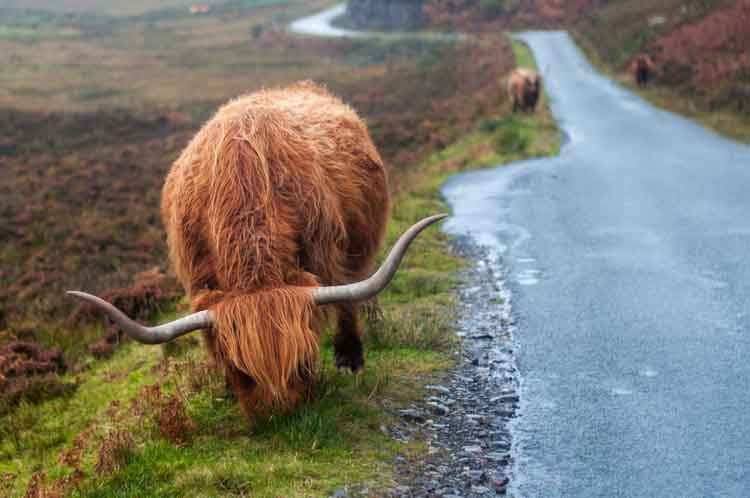
A Highland cow nibbles by the roadside in the Isle of Skye. Image by photographie de paysages / Flickr Open / Getty Images.
Scotland's islands have an edge-of-the-world feel. But you don’t have to go as far as Skye, let alone the Shetland Islands, to immerse yourself in their magic. From bustling Glasgow all it takes is a train ride and a ferry trip (potentially as little as a two-hour journey) to arrive at the Southern Hebrides. Ferry rides between the islands will take you past seals, porpoises and more, while you’ll see red deer and distinctive Highland cows on the larger isles. Here are a few of our favourite islands, each with their own wild appeal.
The brochures call Arran 'Scotland in miniature'. And while Arran isn't technically one of the Hebrides because of its location south of Kintyre, it’s a memorable and easy introduction to the islands. The south, where most people live, is pleasantly wooded; the north is mountainous with plenty of hiking (many of the routes fairly challenging), including Goatfell, the island’s highest peak (5-6 hour return trek). Elsewhere, you can explore Brodick Castle, venture out gorge walking or set sail on a sea kayak. If that all sounds a bit energetic, settle in at one of the island's many cosy pubs, sample great ale at the Isle of Arran Brewery (arranbrewery.com) and whisky at the Isle of Arran Distillery (arranwhisky.com).
Make it happen: ferries (one hour) arrive from Ardrossan on the mainland, which is an easy 50-minute train ride from Glasgow. Arran Adventure Company (www.arranadventure.com) offers outdoor activities.
You might know Islay (pronouced eye-la) for its peaty whisky (including Laphroaig and Ardbeg), and plenty come here just for a tipple. The island itself is a mix of marsh, woodland, scrub and macchair (distinctive grassy, sandy stretches that often shelter wildflowers and seabirds). Not many tourists come, but this is a superb spot for birdwatchers. 250 bird species have been recorded here, and white-fronted and barnacle geese flock to the area in winter. Wildlife tours can help you spot golden eagles year-round. Boat trips head to the famous nearby Corryvreckan whirlpool, a fierce maelstrom caused by bottlenecked tides, or to neighbouring Jura where George Orwell wrote 1984.
Make it happen: you can fly direct from Glasgow, or get the two-hour ferry from Kennacraig, which is accessible by bus (2 hours 30 minutes) from Glasgow. Try the Lady of the Isles (ladyoftheisles.co.uk) for tours.
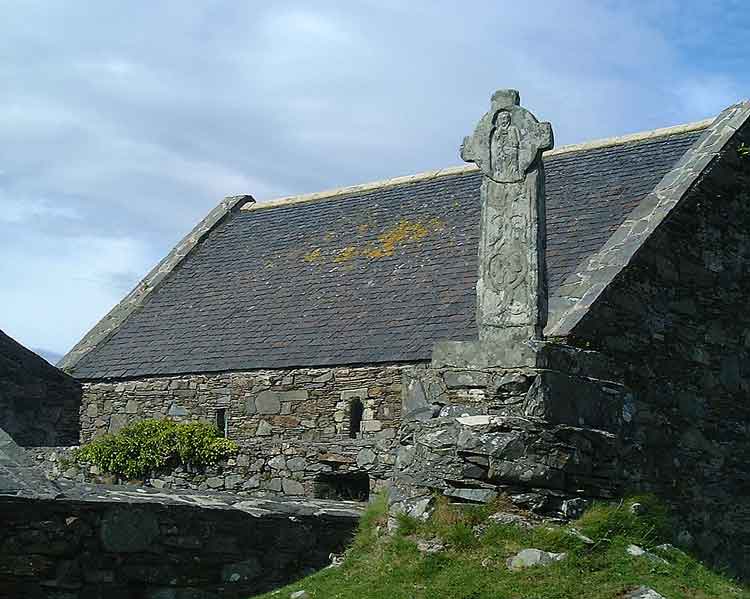
Oronsay Priory by Nige Brown. CC BY 2.0.
Colonsay is also a little off the tourist trail. There are hills and rabbits, lovely sandy beaches, fishing opportunities and formal gardens. But the star is beautiful, medieval Oronsay Priory, which lies on a separate island and has links with St Columba and his disciple Oran, sixth-century Irish missionaries credited with the conversion of Scotland to Christianity. You can drive there, but the walk at low tide across shell-strewn mudflats is a highlight of any visit.
Make it happen: trains from Glasgow on the stunning West Highland line (three hours) stop at the seafood-tastic mainland port of Oban; it’s a two-hour ferry from here. There are few amenities, and you should book accommodation before you go (the standout is the Colonsay Hotel).
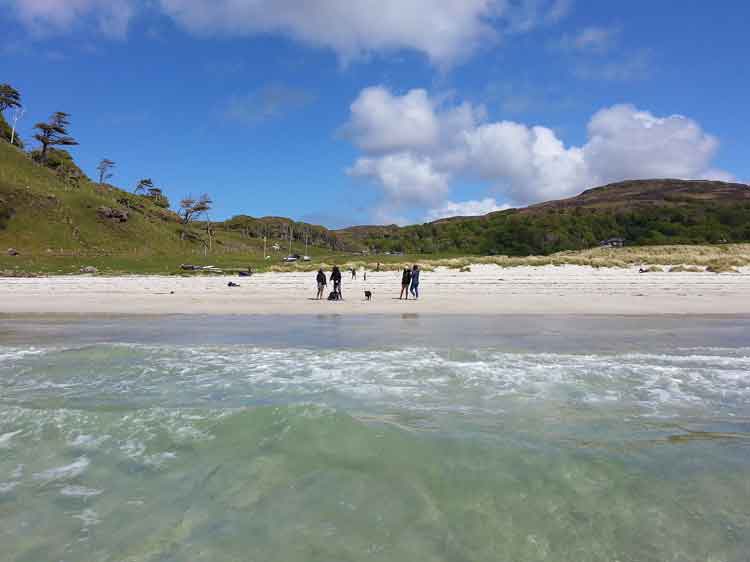
Calgary Bay, in Mull: the Scottish coastline can look almost Caribbean in the sunshine – though the water is a lot chillier. Image by James Smart / Lonely Planet.
North of Colonsay, Mull is blessed with gorgeous beaches (head to the Caribbean-looking – if rarely Caribbean-hot – Calgary Bay) and brightened by colourful housefronts (feast your eyes on the main town, Tobermory). Mull is well connected by ferry, so it's a great base to explore other islands, including the mystical Iona. Towering hills reminiscent of the mainland rear above low-lying beaches, rolling forests and farmland. But look up for some of the finest sights: enormous white-tailed sea eagles (reintroduced from Scandinavia after becoming extinct locally) nest on the island. They can be seen perched high in trees or – if you’re very lucky – swooping down on fish. Trips to spot minke and other whales are also possible – these curious animals will sometimes shadow boats, making you wonder who’s checking out whom.
Make it happen: the ferry from Oban takes 40 minutes. There's accommodation all over the island, with most amenities in the main town of Tobermory, home to the likeable MacGochan's pub (macgochans-tobermory.co.uk).
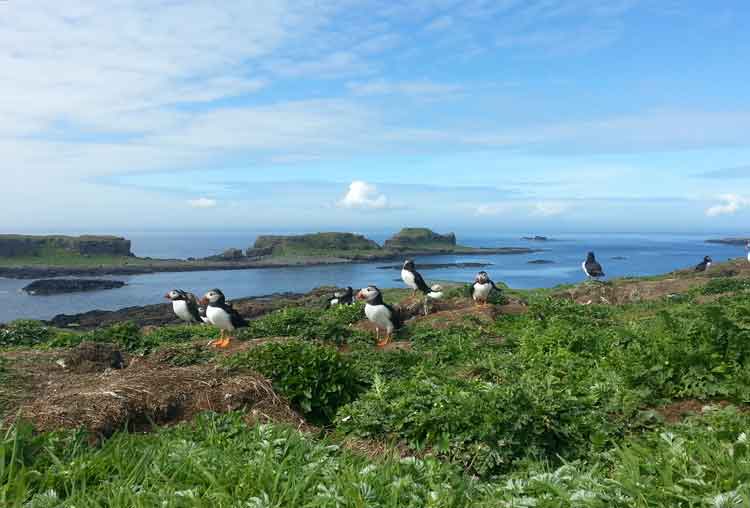
Thousands of puffins nest in clifftop burrows on Lunga in summer. Image by James Smart / Lonely Planet.
This uninhabited island’s gloriously lumpen cliffs and idle rabbit population are entertaining in themselves, but if you come in the nesting season you’ll see something really special. Half-pint sized puffins congregate here in their thousands, diving down from their clifftop burrows into the sea for sand eels before coming back to land with a panicked wobble. They seem completely indifferent to the visitors who stare with open-mouthed joy, and there’s a reason for that – the tourists keep predatory seabirds away. Elsewhere on the island you'll encounter cormorants and guillemots (graceful in the water, smelly when they're crammed next to each other on guano-covered cliffs).
Make it happen: boats run from Mull or Oban for the day visit from April to October – try Turus Mara (www.turusmara.com) or Gordon Grant Marine (www.staffatours.com) – often taking in Staffa too.
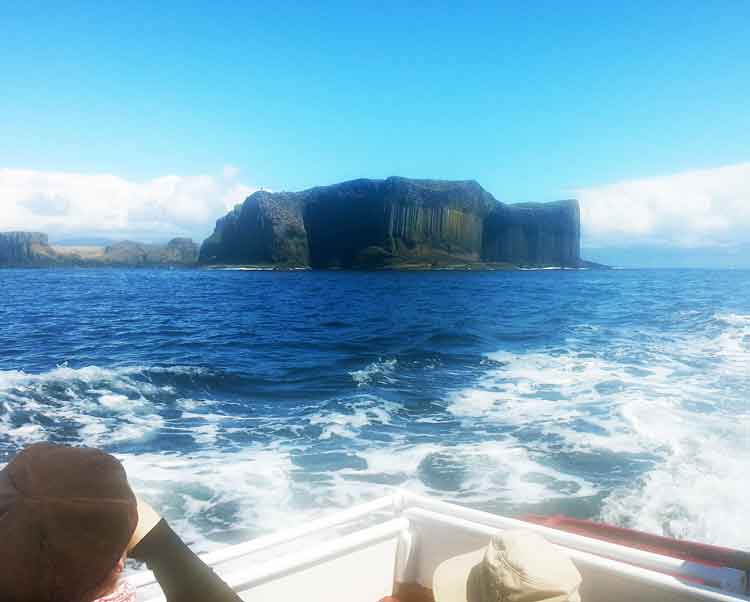
The eerily geometrical rocks of Fingal’s Cave on Staffa have inspired Celtic legends and Romantic poets. Image by James Smart / Lonely Planet.
Fingal’s Cave, a 60m deep, sea-smacked chasm surrounded by hexagonal pillars on the windswept Isle of Staffa, was created by the same great volcanic shifts that produced Northern Ireland's Giant's Causeway. Folk tales have it as the home of the giant Fingal, who threw rocks at his rivals across the Irish Sea. The Victorians revered it – Wordsworth visited, and Mendelssohn wrote a symphony about it. After walking the causeway to the cave's astonishing heart, you can climb the cliffs, sniff the sea air and get your own sense of the epic landscape.
Make it happen: there's not much on Staffa save the cave itself – come here on a day trip by boat from Mull or Oban.
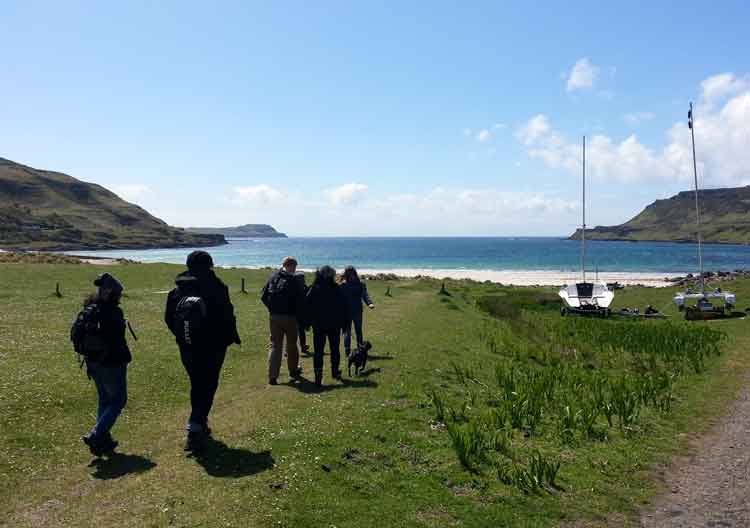
Calgary Bay, in northwest Mull, one of a number of gorgeous beaches on the island. Image by James Smart / Lonely Planet.